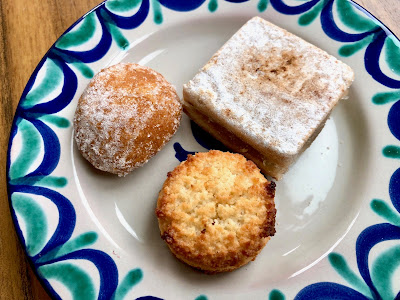Treats from Andalusia, Spain
We came back from Andalusia with a lot of treats! One of them was three kinds of nun's traditional cookies that we bought El Torno in Seville. 1) Cortadillos de Cidra (Citron Slices) by Real Monasterio de Santa Inés - square shape cookies made of two layers of delicate dough, which is similar to Spanish traditional cookies, Mantecados or Polvorones, joined by pumpkin jam, called "cabello de ángel (angel hair)," and covered with powder sugar and cinnamon. The cookie had an unique texture that I would never expect. unique. A nice surprise. 2) Amarguillos by Dominicas Santa María la Real - gluten free cookies made with almond, sugar and lemon. They were light, crumbly and pretty simple and tasty. 3) Borrachuelos de Batata by Monasterio de Monjas Minimas - Borrachuelos (fried dough made with wheat flour, olive oil, sweet wine and brandy and flavored with aniseed and sesame) stuffed with sweet potato fillings. They were like doughnut balls. Flavorful and not overly sweet. I could not guess such interesting ingredients just by tasting, though. By the way Monasterio de Monjas Minimas is located in Malaga, a seaside city in Andalusia, not in Seville.
We also had cookies from Granada. Two pieces of Roscos de Vino (wine cookies) and two pieces of Roscos de Anís (anise cookies). Only Roscos de Vino were covered with power sugar. However, because both cookies were in the same bag during the travel, Roscos de Anís got some sugar from Roscos de Vino. They were a little dry and crunchy and tasted simple but fine, not too sweet even with the sugar dust.
Also a assorted box of chocolate and Yemas de Santa Teresa (candied egg yolks) (some with nuts and some with candied orange peels) from Casa Ysla that J kindly bought on the Valentine's Day. How sweet! They were pretty sweet indeed.
We got local honey in Seville, too. It was orange blossom honey, of course! It is said there are around 40,000 orange trees in the city today. Bitter orange, variety of Sevillian orange trees, which came from Asia, where the orange trees were believed to bring happiness to their owners. With the belief, it got so popular among the Moors in Andalusia, including Seville, to plant the orange trees in a garden and a patio during the Middle Age. Interesting!
We couldn't come back without marmalade. J found a lovely store near our hotel, called Orange Tree Sevilla, that sells various products hand-made with bitter orange and orange blossom from the city. We bought a jar of plain marmalade and a jar of marmalade with raisin and cinnamon. Both were excellent! We also bought fig jam at the food court of El Corte Ingles, which was delightful, too.
Non-sweet treat we brought alone was Spanish olive oil! We happened to find an olive oil specialty shop in Seville. Although we had just bought a can of local olive oil at a local gourmet select store, we checked the shop out anyway and ended up with adding three small bottles of olive oil to our suitcases. The olive oil was produced by Almazaras de la Subbética, a major Agricultural Cooperatives of olive farmers in Sierras Subbéticas Natural Park, located between Córdoba and Granada. We might have seen a part of their olive farms during our train trip. The three kinds of their "Extraordinary Extra Virgin Olive Oils" are Rincón de la Subbética, Parqueoliva Serie Oro, and Almaoliva Arbequino. Each is described as "a true masterpiece," "a real gem" and "an oil with personality" respectively. I am looking forward to finding out what the description exactly means when I open the bottles.
There were more, including an orange flavored dark chocolate bar and J's vermouth. Plus, lovely potteries. We clearly enjoyed shopping during the trip, too.








